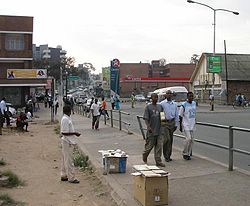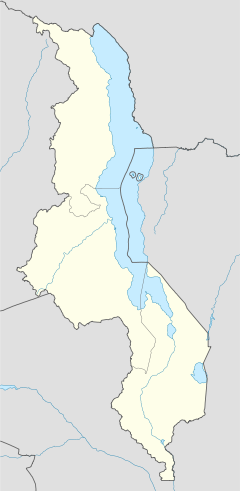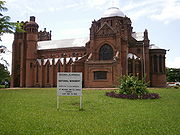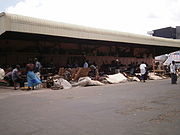
Blantyre
Did you know...
This wikipedia selection has been chosen by volunteers helping SOS Children from Wikipedia for this Wikipedia Selection for schools. All children available for child sponsorship from SOS Children are looked after in a family home by the charity. Read more...
| Blantyre | |
|---|---|
|
|
|
| Coordinates: 15°47′10″S 35°0′21″E | |
| Country | |
| Region | Southern Region |
| District | Blantyre District |
| Population (2008) | |
| • Total | 732,518 |
| Time zone | +2 |
Blantyre is Malawi's centre of finance and commerce and its largest city, by population, with an estimated 732,518 inhabitants as of 2008. It sometimes referred to as the commercial capital of Malawi as opposed to the political capital, Lilongwe. It is the capital of the country's Southern Region as well as the Blantyre District.
The Malawi Broadcasting Corporation (MBC), the country's state broadcaster and the provider of Malawi's only television channel, has its headquarters in Blantyre. The Supreme Court is also located here. The city also houses the College of Medicine, the Malawi Polytechnic and the Kamuzu college of nursing, constituent colleges of the University of Malawi, located along the Chipembere highway. The rather unconventional location of the city has meant that Blantyre is overlooked by Mount Soche, Ndirande mountain, Chiradzulu mountain and Michiru mountain which consolidates the Michiru Mountain Conservation Area.
Blantyre supports a small expatriate population of about 25,000, mainly from England, the rest of Europe, and South Africa.
History
Founded in 1876 through the missionary work of the Church of Scotland, Blantyre's historical importance is rivaled by no other Malawian city. It has many historic and cultural heritage resources, which constitute a vital part of the city and are crucial for its identity, cultural and social well-being and attractiveness to business and tourism. It became a British consular in 1883 and attained municipality status by 1895, making it Malawi's oldest municipality. Blantyre is one of the oldest urban centre in East, Central and Southern Africa; it pre-dates Nairobi, Harare and Johannesburg, hence has the longest historic and cultural heritage in the region. The Museum of Malawi is located next to the Civic Centre offices at Chichiri, and constitutes a valuable asset of the city.
The city's stature as Malawi's centre of commerce and industry began through its role as a centre for colonial trade in ivory. Thus, Blantyre quickly established itself as a crossroads for trade in Southern Africa. Today the city is Malawi's main manufacturing core with shoes, cotton, metal and plastic producing factories located here. From 1876 to 1905, urban development was confined to Blantyre only in three distinct areas within 2 km distance of each other: Blantyre Mission at HHI, Mandala (European commercial venture), and the government zone and commercial centre triangle marked by Haile Selassie Road, Glyn Jones Road andHannover Street. In Limbe development started in 1906 following the establishment of the Shire Highlands Railways Company headquarters and repair and servicingfacilities, and Imperial Tobacco Group (ITG) packaging and tobacco grading factorynearby. As a result of the establishment of these big operations, easy accessibility andflat topography, Limbe experienced a development boom of Indian wholesale and retailshops to the extent that by 1910 Limbe town surpassed Blantyre town. Low andmedium density housing for the European and Asian staff were located in Mpingwe, ITGand Mudi in Limbe and in Mount Pleasant, Sunnyside, Namiwawa, Kabula and Mandalain Blantyre. The Indian shops included accommodation at the rear or on top floor of theshops. High density housing for the African workforce was located far away exceptChiwembe compound in Limbe. The development history of Blantyre was principally dictatedby piecemeal unco-ordinated development as a result of individual and interest groupdecisions relating to evangelism, commerce, farming, industry and administration.
Blantyre is named after the town in South Lanarkshire, Scotland, where the explorer David Livingstone was born. Livingstone's missionary endeavours saw the establishment of the St Michael and All Angels church. The church dates from 1891 and was famously built by a team of local workmen with no knowledge of architecture of building techniques. Urban development was further stimulated by the construction of the railway. In 1956 it was merged with its sister city, Limbe, to form one city. The Museum of Malawi is located next to the Civic Centre offices at chichiri, and constitutes a valuable asset of the city. However, the current level of protection and conservation of resources is inadequate mainly because of inadequate financial resources, lack of a comprehensive conservation plan for the city, and the seemingly low priority accorded to the sector by Government. Blantyre City has a total of 8 gazetted National Monuments, mostly buildings of historic importance. Besides, the City Assembly has nominated 2 resources for designation as National Monuments, and another 23 resources for investigation with regard to their eligibility for designation as National and local Monuments.
Geography
Blantyre City, the largest urban centre and commercial and industrial capital of Malawi,is located in the Shire Highlands and geographical centre of the Southern Region of the country and lies at 35° East of Greenwich Meridian and 15° 42"South of the Equator. It is a transport communications node with road, rail and air links to all parts of the country and neighbouring countries of Mozambique, Zimbabwe, SouthAfrica, Zambia and Tanzania. It covers an area of 228 km2. The city is classified as a‘National Urban Centre’ within the designated six hierarchical levels system of urban centres of the country, and is also the regional administrative headquarters of the Southern Region.
The geology of the city consists of two principal types of rocks of an ancient Basement Complex, as a result of a process which took place during the late Pre-Cambrian period about 500 million years ago. The most extensive rock formation consists of pyroxene granulite gneiss which covers more than 50% of the city area, from the north-west to the east and extends in two small bands southwards in the western part of the city; and syenitic gneiss which accounts for about 40% covering the southern, western and northeastern corner of the city and also in form of scattered small intrusions into the pyroxene granulite gneiss. In their unweathered state, both rock types are impervious hence poor acquifers, but they provide a valuable resource for road and building construction. Blantyre City is located on the eastern edge of the Great Rift Valley, and thus some prominent faults occur within and in the vicinity of the city rendering it prone to earthquakes. The main faults and associated zones of deeply fractured bedrock run from the north of the city in a south-westerly direction, and are potential acquifers for groundwater.
Blantyre City lies in a hilly area hence has varied topography ranging from an elevation of about 780 to 1,612 metres above sea level. There are three main types of topographical features, which have major implications for the development of the city,and comprise the hills, plateaux and ridge and the natural drainage system. The most conspicuous and dominant physical feature of the city is the numerous residual hills which are found in all parts of the city. The main hills are the headwaters of several rivers and streams which originate and radiate from the city, forming a natural drainage system with nine distinct catchment areas namely, Likhubula, Lunzu, Mombezi and Khombwi, which drain the northern part of the city, and Mudi, Chisombezi, Limbe,Luchenza and Mwampanzi draining the middle and southern parts. Because of the hilly topography, these natural drainage channels are narrow and have steep sides and gradients. The plateaux and ridge comprises all the land which is suitable for urban development including extensive relatively flat land, the mountain piedmonts and plains,and long narrow watersheds and strips of land which separate the rivers and streams.
Climate
The climate of Blantyre is greatly influenced by its location within the tropical zone and altitude. The city experiences the Tropical Continental Climate with two distinct seasons in the year. The rainy season is from November to April, with a continuation inform of light cold showers locally known as ‘Chiperoni’ from end of May to July. The dry season is from May to October. The mean annual rainfall is 1,122 mm (44.17 in), of which about 80% falls within 3½ months between November and March. The city is generally cool with mean annual temperatures ranging from 13 °C (55 °F) during the cold season (May to July) to 21 °C (70 °F) during the hot season (September to November). There are particularly two spells of uncomfortable weather; the hottest season associated with high humidity soon before the onset of the first rains (end October to November), and the frost along rivers, mist and chilly showers and winds characteristic of the cold season in June and July.
Demographics
Economy
Blantyre City, as the commercial and industrial capital of the national economy, has a strong solid economic base for sustained economic growth, and a diversified moderneconomy offering a wide range of employment opportunities. The commerce, trade and industry sector is the leading driving force of economic development in Malawi second only to agriculture and, therefore, a major contributor to GDP. It is by far the major employment generator in the city and has the greatest multiplier effect on the urban economy. The city is Malawi's industrial centre with many manufacturing plants located here. There are eight designated industrial areas namely Makata, Ginnery corner, Maselema, Limbe, Chirimba, South Lunzu, Maone and Chitawira. Of these Makata, Ginnery corner, Maselema, Limbe, Chirimba and Maone are actively hosting industries whilst South Lunzu is yet to be developed.
The existing industrial sites are further categorized into heavy and light industrial sites. Makata and Limbe, for example, are the sole heavy industrial sites hosting more than thirty companies.
Whilst Chirimba industrial area, though designated a heavy industrial area, is the least developed in terms of number of industries in the area. Apart from Makata, Ginnery corner industrial site is another active site followed by Limbe and Maselema and the least is Chirimba and Maone industrial sites. Chitawira and Maselema are classic examples of light industrial areas (Blantyre City Assembly,1999). All the industrial areas are located along the banks of the main rivers or streams of Blantyre city. Makata industrial area lies between Mudi and Nasolo streams whilst Ginnery corner industrial area is along Mudi River. Maselema industrial area exists along the Naperi river and Chirimba stream hosts Chirimba industrial area. There are several rules for treatment of wastes in the industries (Local Government Act, 1982; Blantyre City Assembly, 1999) but disposal of untreated wastewater into drains and subsequently into the city's major streams is very common, thus posing a potential health and environmental risk to the people living in the city of Blantyre and downstream. Other sources of water pollution in the city such as runoffs from domestic and agricultural activities and also vehicular emissions (Lakudzalaet al., 1999; Masamba and Chimbalanga, 2001, Sajiduet al, 2007) have been identified. Previous studies have indicated substantial heavy metal pollution in the city's water bodies including streams (Lakudzala et al., 1999; Sajidu et al., 2007; Kaonga et al., 2008). However major changes in industrial activities have occurred in the city including decrease in volumes of wastewater generated by David Whitehead company which used to be a major contributor of wastewater effluent in Makata industrial area; change of ownership and wastewater management of Cold Storage Company; closure of the Shire Bus Line; doubling of wastewater generation from both Carlsberg and Chibuku Products due to increase in production and installation of some industrial pretreatment plants such as at Chibuku, Plascon and Dulux.
Manufacturing contributes approximately 14% to GDP. In the period 1996 – 1999 the sector showed 0% growth, partly due to the rapid liberalisation of markets exposing Malawi’s manufacturers to competition from South Africa and Zimbabwe. The sector is still hampered by monopolistic behaviour (cotton), trade barriers, lack of access to capital, illegal imports, and unpredictable implementation or lack of implementation of existing bilateral trade agreements.
The employment structure of the city is of two categories comprising formal and informal sectors, together offering employment which is estimated to be between 50,000 and 55,000 jobs and thus absorbing 62% of the labour force. The formal sector employment consists of primary, secondary and tertiary industry subsectors, and the informal sector is principally small scale business operations. The tertiary or services industry sub-sector is leading in terms of employment creation and importance to the economy of the city; it employs a total of 26,074 people accounting for 56.5% of total formal employment. The secondary industry sub-sector employs 18,824 people principally in manufacturing and accounts for about 41% of the total employment. Information on informal sector activities is scanty or non-existent. But a recent study by Africon and field investigation under the Blantyre City Environmental City Profile, leads to the conclusion that it is a substantial and vibrant economy, offering employment to about 4,500 people who would otherwise be unemployed.
Blantyre is also home to the Malawi Stock Exchange located on Victoria Avenue, the heart of the city. It opened its doors in November 1996 and operates under the Capital Market Development Act 1990 and the Companies Act 1984. Prior to the listing of the first company, the major activities that were being undertaken were the provision of a facility for secondary market trading in Government of Malawi bonds namely, Treasury Bills and Local Registered Stocks.
As Malawi's main economic and financial hub, the city plays host to an international trade fair every year which takes place during the month of May. The event seeks to showcase the best of Malawian commerce, industry, agriculture and information technology and opened under a theme of “Building Productivity Capacity to Achieve Export Competitiveness” in 2007.
On January 15, 2007, it was revealed that Zimbabwe-based bus and truck building firm AVM Africa (Pvt) Limited will be investing over K100 million to buy and renovate a site in Makata with the intention of building buses and trucks in Blantyre. The company plans to employ about 1,000 people — all locals, in the manufacturing venture and AVM Africa is expected to also subcontract about 10,000 others for production work.
Infrastructure
The city has a reasonably well developed system of both physical and social infrastructure including roads, reticulated water, electricity, sanitation, fire protection, health, education and commercial and recreational facilities. But most of these essential services are characterised by many problems especially low level of coverage, poor state of maintenance and disrepair, frequent disruption of service and management shortcomings.
Malawi's largest stadium, Kamuzu Stadium, which holds and estimated 60,000 is situated in Chichiri. International football games are played here as well as major Malawian events such as Presidential inaugurations and Independence day celebrations.
Transport
Blantyre City is served by a road network totaling about 554 km consisting of sixcategories of roads namely, designated, collector, distributor, residential, industrial and access roads in descending order of importance or traffic volumes. Very fewformal footpaths exist in the city besides sidewalks, although the predominant mode of travel is walking.
Traffic has increased tremendously in the past few years mainly due to the liberalisation of the economy and overall economic development growth. The most noticeable being private cars and minibuses which have completely replaced buses as means of public transport in the city. Minibuses, a main fixture in most African cities, begin services from the early hours while the last services usually finish by 7 O'clock pm. The Taxis mainly found outside the city's top hotels, Mount Soche and Ryalls, also provide an alternative mode of transport to the residents of Blantyre.
Railway services contribute enormously to the city's status as Malawi's main commercial and industrial hub. The Central African Railways Co. (formerly Malawi Railways) has its headquarters in Limbe. It operates via Blantyre to Nsanje, near the southern border with Mozambique which connects Malawi with the Mozambican ports of Beira and Nacala, Mchinji, near the border with Zamibia, Salima and Lilongwe, and between Nkaya and Nayuchi on the eastern border with Mozambique, covering a total of 797 km. There is a rail-lake interchange station at Chipoka on Lake Malawi, from where Malawi Railways vessels operate services to other lake ports in Malawi. In September 2007, President Bingu wa Mutharika commissioned locomotives donated by the Taiwanese government which will provide passenger train services for Blantyre to other parts of the country. A government subsidised passenger rail service operated thrice weekly from Blantyre to Makhanga and to the border with Mozambique at Nayuchi prior to this.
Chileka International Airport located approximately nine miles from Blantyre city centre has two runways which serve Blantyre with flights to South Africa and other African countries. The airport is the main base for the country's flagship airline, Air Malawi. Chileka airport also houses important weather stations. In 2007, the Government of Malawi proposed expansion plans which are yet to be realised. In 2009 it was announced that the Government of Malawi was seeking partners for a $1 billion dollar rehabilitation of the airport which will include the construction of a new terminal building and the widening of the current runway.
The city also has coach services which run from the city centre and Wenela bus station to Lilongwe, Mzuzu and other African capitals including Johannesburg and Harare.
Shopping
As the commercial centre of Malawi, travelers come in from all over the region (including neighboring Mozambique) to stock up on supplies—food, construction materials, electronics, etc. The downtown area is full of Asian (Indian) run shops, as is nearby Limbe. A bustling market area popular with locals offers all kinds of fruit, vegetables, used clothing, construction materials, etc. at a cheap price.
Newer Western-style shops are available for those who just want to get in and get out at Chichiri Shopping Centre, arguably Malawi's largest mall. The mall offers consumers a wide range of facilities from banking and ATM services from: Standard Bank, NBS Bank, MSB Bank, National Bank of Malawi, Western Union and other Forex bureaus, telecommunication services such as Zain, Telekom Networks Malawi, MTL, many fast food restaurants such as Nandos, Hungry Lion, Jungle Pepper Pizza, Curry Corner Indian Food, retailers such as: Shoprite, Game Stores, a movie theatre, furniture shops, clothing stores, book stores, pharmacies, dental surgery, optician, Digital Photo Express, florist and even hair dressers.
Alternatively, Savers Choice is a well-stocked Asian run store heading toward Limbe that caters to the expat community with hard-to-find food items, a good bakery, an ice-cream bar and candy shop. Prices for the same thing can often vary from shop to shop and an abundance of counterfeited products flood the market, so it is best to shop around and stay on guard.Blantyre's Biggest Shopping Complex, Housing Shoprite, Game Stores and a number of Private shops and Banks
Education
Blantyre City has a wide range of educational facilities comprising primary school,secondary school and tertiary education as well as pre-school. These are provided by the government, City Assembly, missionary institutions and the private sector.
Tertiary education comprises technical and vocational training and higher learning institutions mostly located in the Chichiri-Ginnery Corner area (Malawi Polytechnic,College of Medicine, Kamuzu College of Nursing, Blantyre School of Health Sciences and Malawi College of Accountancy), Telecommunications National and SADCC Multi-Country Training Schools, Technical School, Police Training School and Blantyre Teacher’s College. However, some private companies offer tailor-made training to their staff (Malawi Railways, ADMARC, banks, etc.) while individual entrepreneurs provide specialised training in varied fields such as management, secretarial, business,accounting, and computers.
There are 50 primary schools in the city with a total enrollment in 1999 of approximately 134,000 pupils. This is less than 40% of the required schools resulting in excessive overcrowding of classrooms, long distance travel to/from school, unacceptably high pupil/teacher ratios and high proportion of pupils who hold classes outside under tree shades. The combination of overcrowding, inadequate and poorly maintained pit latrines, and learning in the open is exacerbating health hazards and deterioration of environmental quality in public school.
In spite of this Blantyre city probably has the most number of schools out of any other Malawian City offering western standard education. These include Saint Andrews International Primary and High School, Central High School, St Patricks Academy, Phoenix Primary School, Hillview School and Kalibu Academy.
Health
The health care delivery system in the city comprises both curative and preventative health care services, and this is provided through a network of hospitals and health centres/clinics which are distributed in different parts of the city.The government runs Queen Elizabeth Central Hospital (QECH), the biggest referral hospital in the country, which has a total of 1,000 hospital beds, and the three private hospitals, have a total of 122 hospital beds. The 18 public clinics are run by the District Health Office in partnership with the Blantyre City Assembly and comprise Bangwe, Chigumula, Chilomoni, Chirimba, Limbe, Ndirande, Manyowe, Masala, Mapanga, Misesa, Mzedi, Nancholi, Nkolokoti, Ntenje, Ntonda, South Lunzu, Zingwangwa and Civic Centre.
There are several clinics run by religious organisations where people get paying health care services, and those owned by statutory corporations/companies (serving their staff) such as ADMARC, Malawi Railways, Portland Cement, Lever Brothers, Tobacco Processors, and National Seed Company of Malawi. Following the liberalisation policy, the city has witnessed the establishment of many private clinics and hospitals (including Blantyre Adventist Hospital and Mwaiwathu PVT Hospital, arguably the country's best medical facilities) which complement the few limited old facilities. The majority of these offer out-patient services while the few well established ones offer both. Besides the city-based health services, many city residents make regular use of mission hospitals which are located outside the city to the extent that these form part of the health delivery system of the city (Mlambe Hospital and Nguludi). In addition, Traditional healers (herbalists) and Traditional Birth Attendants (TBAs) also play an important role in providing health care to the city residents in form of curative and maternal delivery services respectively.
The health delivery system of the city is grossly inadequate. The public hospital wards are very congested and long queues are characteristic of outpatients services. The average clinic-population ratio for the city is between 25,000 and 28,000 persons per clinic, and the unplanned settlements are the least served with over 40,000 persons per clinic, compared with the recommended urban planning standard of 10,000 persons per clinic.
Mwaiwathu Private Hospital and Blantyre Adventist Hospital provide the best medical services in the city, with many residents from Lilongwe travelling to Blantyre to receive treatment from the Hospitals.
International relations
Blantyre is twinned with Hanover in Germany.




